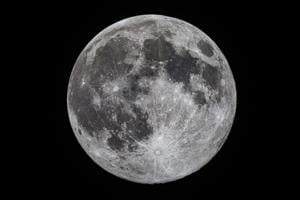Science
Earth’s Orbit Hosts Asteroid, Sparks Moon-like Speculation

A significant development has occurred in Earth’s orbit with the arrival of a large asteroid, igniting discussions among scientists about its similarities to the Moon. Although some reports suggest the asteroid might qualify as a second moon, experts caution that it does not fulfill the criteria to be considered an equal counterpart to Earth’s natural satellite.
The asteroid has been observed rotating around the planet in a pattern reminiscent of the Moon’s orbit. This unusual behavior has led to speculation about whether it could be classified as a second moon. However, experts emphasize that while its orbital path resembles that of the Moon, it is fundamentally different in composition and characteristics.
Understanding the Discovery
The asteroid’s entry into Earth’s orbit has caught the attention of astronomers and space enthusiasts alike. Initial observations indicate that it is approximately 1,000 meters in diameter, making it a significant object in size. Its orbit around Earth appears stable, but it is classified as a temporary satellite rather than a true moon.
According to Dr. Sarah Mitchell, an astrophysicist at the International Space Research Institute, “While the asteroid’s movements might mimic those of the Moon, it lacks the geological and historical significance associated with our natural satellite.” This distinction is vital in understanding the role of such asteroids in our solar system.
The classification issue arises from the definitions used in astronomy. A true moon is a natural satellite that has formed alongside a planet, while temporary objects like this asteroid can be captured by a planet’s gravity but do not originate from it.
Impact on Scientific Understanding
The excitement surrounding this discovery underscores the importance of continued observation and research. Scientists intend to monitor the asteroid to gather more data about its trajectory and physical properties. This information could enhance our understanding of how celestial bodies interact within our solar system.
Moreover, the discovery raises questions about how many objects might be temporarily captured by Earth or other planets. Dr. Mitchell adds, “This event opens a window into the dynamics of our solar system and how it has evolved over time.”
While the asteroid may not be classified as a second moon, its presence serves as a reminder of the dynamic nature of celestial bodies and their interactions with Earth. The scientific community will continue to study this phenomenon to gain insights into the complexities of space.
In conclusion, while the asteroid’s behavior has fueled speculation about a second moon, experts reaffirm that it remains a temporary space visitor, providing an opportunity for further exploration and understanding of our universe.
-

 Sports1 week ago
Sports1 week agoSteve Kerr Supports Jonathan Kuminga After Ejection in Preseason Game
-

 Politics1 week ago
Politics1 week agoDallin H. Oaks Assumes Leadership of Latter-day Saints Church
-

 Lifestyle1 week ago
Lifestyle1 week agoDua Lipa Celebrates Passing GCSE Spanish During World Tour
-

 Business1 week ago
Business1 week agoTyler Technologies Set to Reveal Q3 2025 Earnings on October 22
-

 Entertainment1 week ago
Entertainment1 week agoZoe Saldana Advocates for James Cameron’s Avatar Documentary
-

 World1 week ago
World1 week agoD’Angelo, Iconic R&B Singer, Dies at 51 After Cancer Battle
-

 Science1 week ago
Science1 week agoChicago’s Viral ‘Rat Hole’ Likely Created by Squirrel, Study Reveals
-

 Lifestyle1 week ago
Lifestyle1 week agoKelsea Ballerini Launches ‘Burn the Baggage’ Candle with Ranger Station
-

 Health1 week ago
Health1 week agoRichard Feldman Urges Ban on Menthol in Cigarettes and Vapes
-

 Health1 week ago
Health1 week agoCommunity Unites for Seventh Annual Mental Health Awareness Walk
-

 Business1 week ago
Business1 week agoMega Millions Jackpot Reaches $600 Million Ahead of Drawings
-

 Business1 week ago
Business1 week agoMLB Qualifying Offer Jumps to $22.02 Million for 2024









